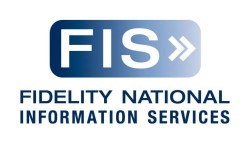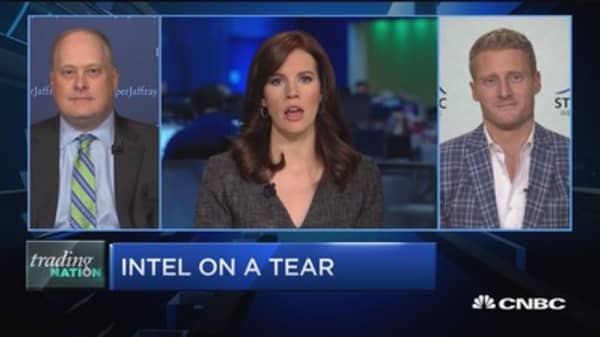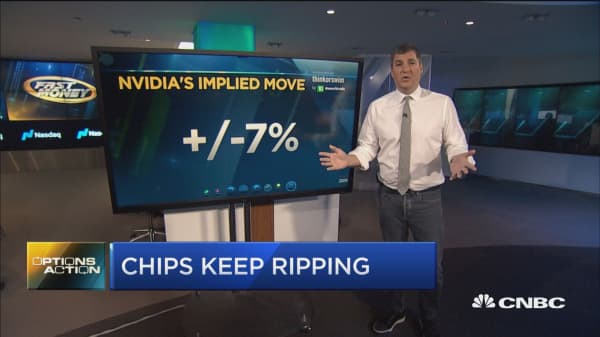
Image source: The Motley Fool.
Aeglea BioTherapeutics (NASDAQ:AGLE) Q4 2018 Earnings Conference CallMarch 7, 2019 4:30 p.m. ET
Contents: Prepared Remarks Questions and Answers Call Participants Prepared Remarks:
Operator
Greetings, and welcome to the fourth quarter 2018 corporate update and earnings call. [Operator instructions] As a reminder, this conference is being recorded. I would now like to turn the conference over to your host, Mr. David Calusdian.
Thank you, Mr. Calusdian. You may begin.
David Calusdian -- Investor Relations
Hello and welcome to Aeglea BioTherapeutics corporate update and earnings conference call. After management's prepared remarks, they will be available to take your questions. Before we begin, please note that today's call may include a number of forward-looking statements, including comments on the company's business strategy, strengths and priorities; the timing, plans and success of clinical trials and related data; the timing of announcements and updates relating to clinical trials and related data; the safety, therapeutic benefits and economic value of product candidates; the advancement of technologies and proprietary product candidates; regulatory pathways for development programs; the success of collaborations; the competitive landscape for product candidates; trends with respect to revenues, expenses and cash flows; the company's ability to fund research and development programs; and its ability to manage costs, along with the uses of cash and other matters. These forward-looking statements are based on assumptions that are subject to risks and uncertainties that could cause the company's actual results to differ significantly from those suggested by these statements.
Given these risks and uncertainties, you should not place undue reliance on these forward-looking statements. Please refer to the company's Form 10-K, filed with the Securities and Exchange Commission on March 7, 2019, for some of the important risk factors that could cause its actual results to differ materially from expectations, including any forward-looking statements made on this call. Except as required by law, the company disclaims any obligation to publicly update or revise any forward-looking statements to account for or reflect events or circumstances that occur after this call. Also, please note that a presentation to accompany this call is available for download on the events and presentations page of the company's IR section of its website at www.aegleabio.com.
I'll now turn the call over to Aeglea's Chief Executive Officer Anthony Quinn. Dr. Quinn, please go ahead.
Anthony Quinn -- Chief Executive Officer
Thank you, David, and good afternoon, everyone. Thank you for joining us. With me today are Charles York, our chief financial officer; and Dr. Jim Wooldridge, our chief medical officer.
2018 was a really successful year for Aeglea with substantial progress on a number of fronts and we've had a great start to 2019. In 2018, we made significant advances with our clinical programs for pegzilarginase in Arginase 1 Deficiency and oncology. We leveraged our unique drug-hunting capabilities to generate new pipeline programs for cystinuria and homocystinuria. We made significant progress in strengthening the company's balance sheet, which will allow us to continue to invest in our lead program and our pipeline.
As we look to 2019, the company is well-positioned to advance both our programs and leverage our unique human-enzyme design capabilities. We're continuing our investment in our lead product candidate, pegzilarginase, pipeline programs and accelerating our manufacturing activities. We've continued to build the team and our capabilities. We accelerated our plans to do a financing in 2019, and we closed an offering in February of this year, which resulted in total gross proceeds of $69 million, further strengthening our balance sheet and positioning us for success in 2019 and beyond.
We continued to build on the rapid progress we've made last year on our clinical experience with pegzilarginase in Arginase 1 Deficiency. The Phase I/II data continues to develop with 14 patients who have now completed eight weeks of repeat dosing. We have an oral presentation at SIMD and will be providing an update on Phase I/II data at that meeting in Seattle, Washington in early April. As you all know, we have also been progressing studies on investigating the impact of arginine depletion with pegzilarginase in patients with advanced solid tumors.
We have now completed enrollment in the single-agent expansion trials. We've also made good progress with a combination trial. Our early stage preclinical programs for homocystinuria and cystinuria, which address two more common rare diseases with significant unmet medical needs also continued to advance forward with the initiation of the IND-enabling studies. We're continuing to leverage our knowledge of biology, human metabolism and enzymology as we address diseases that are significant unmet medical needs.
We're really excited about the opportunities ahead for our programs at Aeglea, and I'm very much looking forward to updating you on our progress as we move through 2019. I'm going to now turn the call over to Jim, who will walk you through our 2018 achievements and also discuss our plans for 2019. Jim?
Jim Wooldridge -- Chief Medical Officer
Thanks, Tony, and hello, everyone. As Tony mentioned, 2018 and the start of 2019 have been a productive and data-rich time at Aeglea in both rare disease and oncology. First, with our lead investigational therapy, pegzilarginase for Arginase 1 Deficiency, we completed dosing on our Phase I/II clinical trial. Importantly, the data we generated in this study was critical to inform the design of our pivotal Phase III PEACE trial.
While this was one of the biggest highlights, we also made important advances with our oncology trials in our pipeline molecules. In 2018, we completed enrollment to the single-agent Phase I trial in advanced solid tumors, including the cohort expansions in heavily pretreated patients with cutaneous melanoma, uveal melanoma and small cell lung cancer. In the fourth quarter, we presented interim clinical data at ESMO confirming the monotherapy safety profile and demonstrating antitumor activity with pegzilarginase in heavily pretreated patients with melanoma. In December, we also completed the Phase Ib dose-escalation trial of pegzilarginase in combination with KEYTRUDA and initiated enrollment into Phase II.
This Phase II study is designed to assess safety and efficacy in patients with extensive disease small cell lung cancer, who relapsed or progressed following platinum-based chemotherapy. From our Phase I trial, we confirmed the safety profile was consistent with prior pegzilarginase monotherapy observations and a recommended pegzilarginase Phase II dose of 0.27 milligrams per kilogram was selected in combination with KEYTRUDA. More importantly, we observed clinical activity in the nine patients treated at this dose level, including stable disease in three at nine weeks and one partial response. We expect top-line data from this trial in the first half of 2020.
We continued to be excited about progress with our pipeline. In October, we presented preclinical data on AEB4104, our new pipeline program for homocystinuria that has the potential to dramatically lower plasma homocysteine levels. In a preclinical model of homocystinuria, AEB4104 led to improvement of significant disease-related manifestations, including improved survival. Also, in October, we presented data at the American Society of Nephrology, highlighting the discovery and activity of a novel cystine-degrading enzyme based on a human scaffold.
In a preclinical model of cystinuria, our cystine-degrading candidate reduced plasma and urine cystine levels, inhibited crystal formation in urine and was accompanied by reduced kidney stone formation. We already started IND-enabling activities for both of these pipeline programs and we look forward to bringing both programs toward the clinics in 2020. Turning now to pegzilarginase for Arginase 1 Deficiency. We announced in December the design of our global pivotal Phase III PEACE study, which we aligned a feedback from FDA and EMA.
PEACE stands for Pegzilarginase Effect on Arginase 1 Deficiency Clinical Endpoints and is a global randomized and double-blind trial designed to assess the effects of pegzilarginase versus placebo over 24 weeks. The primary endpoint is plasma arginine reduction and secondary endpoints include mobility and adaptive behavior as assessments of clinically meaningful effects, in addition to safety and pharmacokinetics. At the end of last year, we released guidance that we expect to dose the first patient on the PEACE trial in the second quarter of 2019. And we are on track to meet this milestone.
As we've discussed before, pegzilarginase is highly effective in reducing plasma arginine levels. Data from the Phase I/II studies support a weekly dose of 0.1 milligrams per kilogram, which should establish rapid control of plasma arginine in the PEACE trial. In the Phase I/II trial, reductions in plasma arginine levels were accompanied by improvements in important disease-related abnormalities after only eight weeks of repeat dosing. Given the importance of good plasma arginine control, it's anticipated that the proportion of clinical responders will increase with longer treatment in that trial.
Insights from standardized clinical assessments and feedbacks we've received from physicians and caregivers indicate that the assessments of mobility and adaptive behavior are ideally suited to capture the clinical benefits of pegzilarginase. In summary, 2018 was a highly productive year and we look forward to a successful 2019 with initiation of the PEACE trial, advancing our combination study with KEYTRUDA in small cell lung cancer and bringing our two exciting pipeline programs closer to the clinics. Furthermore, we are confident and excited with the PEACE trial design, and we expect the data from this trial will be sufficient to support marketing applications for pegzilarginase in Arginase 1 Deficiency. With that, I'll turn the call over to Charles to discuss the financials.
Charles York -- Chief Financial Officer
Thanks, Jim, and good afternoon, everyone. As Anthony discussed earlier, we took important steps to strengthen our balance sheet already in 2019 by completing a $69 million financing in early February. The net proceeds, which came from new and existing investors provide us with pro forma cash of approximately $139 million at December 31, 2018. More importantly, this capital is expected to provide Aeglea with cash runway through our PEACE pivotal trial readout in the first quarter of 2021.
Regarding our 2018 financials, we continued to invest in key rare disease and cancer programs at Aeglea, which we believe will be the foundation of our long-term success. We recorded a net loss of $14.9 million or $0.62 per share in the fourth quarter of 2018, compared to a net loss of $6.5 million or $0.39 per share on $1.5 million of grant revenue in the fourth quarter of 2017. All 2018 and 2017 revenues at Aeglea were the result of our $19.8 million cancer research grant. That grant contract concluded in May of 2018 with the full $19.8 million of grant revenue recognized over the life of the award and the full cash balance received by year-end 2018.
Operating expenses increased in 2018, given our strategy to drive forward with pegzilarginase in Arginase 1 Deficiency and concurrently develop additional product candidates. Looking at R&D. Our fourth quarter 2018 R&D expense was $11.8 million versus $5.8 million in the fourth quarter of 2017. And for G&A, our fourth-quarter 2018 G&A expense was $3.5 million versus $2.3 million in the fourth quarter of 2017.
The increase in operating expenses were primarily due to advancing the clinical development of our lead program, pegzilarginase; accelerate manufacturing and strengthening our product development capabilities. During 2018, our expenses supported over enrolling our Phase I/II clinical trial in patients with Arginase 1 Deficiency, continuing our open-label expansion trial in patients with Arginase 1 Deficiency, completing enrollment in our three solid tumor single-agent cohort expansion trials and completing enrollment in the Phase Ib combination trial in patients with small cell lung cancer. Now looking forward to 2019. We anticipate our burn will be in the range of $12 million to $15 million per quarter, with the exception of the first quarter of 2019, where we anticipate our burn will be in the range of $15 million to $17 million, given our ramp in pipeline development and manufacturing activities for pegzilarginase in Arginase 1 Deficiency.
And the pro forma cash of approximately $139 million at December 31, 2018, and extension of our cash runway through our PEACE pivotal trial readout in the first quarter of 2021 were important steps in strengthening our balance sheet. Additionally, the early data we've shared in homocystinuria and cystinuria continued to drive investment in both programs. We believe there is significant unmet medical need in both indications, and that we will benefit from a favorable market position, where we own worldwide rights and most importantly, where we believe our assets are differentiated and compelling. I will now turn the call back over to Anthony for some final remarks.
Anthony Quinn -- Chief Executive Officer
Thanks so much, Charles. So in closing, we believe we are really very well-positioned to make meaningful progress toward our goal of providing transformative therapies to patients living with devastating diseases. And we're very appreciative of all the hard work of our employees and also importantly, the support that we get from patients, caregivers and investigators that are involved in our clinical trials. We're really excited by the multiple 2019 milestones ahead and very much looking forward to sharing these updates with you as we actually course through 2019.
We'll now open the call to questions. Operator, can you go ahead? Thank you.
Questions and Answers:
Operator
Thank you. [Operator instructions] Our first question comes from the line of Josh Schimmer of Evercore ISI. Please proceed with your question.
Josh Schimmer -- Evercore ISI -- Analyst
Yeah, thanks for taking the questions. Hey, as the INDs the for cystinuria and homocystinuria programs approach, maybe you can give us a sense of how you expect each one of those two evolve, what the approvable end points might look like, when you might be able to establish initial clinical proof of concept. Thanks.
Anthony Quinn -- Chief Executive Officer
OK, Josh. Thanks for the question. So let me start with homocystinuria program. Obviously, we presented very exciting data at the end of last year, showing that we have an enzyme, it lowers homocysteine levels in a disease model, it creates disease-related abnormalities and proves survival.
So in homocystinuria -- and there's actually a lot of information linking homocysteine levels -- good control of homocysteine levels to control of the disease complications. So that's fairly well established. It's not a surrogate endpoint and obviously, we're going to have to have some discussion with the regulatory authorities. But the evidence available is pretty compelling about the importance of controlling homocysteine levels.
It's a rare disease and we expect basically to go into the patient population, which means that we will get that readout of homocysteine lowering effects relatively early in the development program. What I really like about these models in the rare disease though is that the translatability of what you see in the animal model to what you're going to see in humans is very high. So we actually have a lot of confidence as we move forward with our homocystinuria program. So for cystinuria, cystinuria actually is on the FDA's list of surrogate endpoints.
So that's actually a great place to start. We've come up -- obviously, we've got a very novel approach. We've got some very compelling data, showing by lowering plasma levels of cysteine, we lower urine levels, we inhibit crystallization, we inhibit stone formation. And again, same thing, highly translatable animal models.
So therefore, we would expect and the observation that we've seen in the model, high probability of seeing that as we carry over into humans. And obviously, we have given some guidance with our timelines. So for our homocystinuria, we're guiding that we will actually anticipate having our IND filed in the first quarter of 2020. And then for cystinuria we're guiding the IND in the second half of 2020.
Josh Schimmer -- Evercore ISI -- Analyst
Great. Thanks very much.
Operator
Our next question comes from the line of Matthew Luchini of BMO Capital Markets. Please proceed with your question. Once again, Matthew your line is live. Please proceed with your question.
Double check to see if your line is on mute.
Unknown Speaker
Hi. This is Steven on for Matthew. Thank you for taking our call. Could you give any color on responses from the SCLC cohort in the Phase I trial? Or maybe some timing on when we might see the data? And then because of the success of patient identification program for ARG1-D, you guys said that the incidence may be greater than you initially thought.
I was wondering if you had any update on the prevalence you thought there was.
Anthony Quinn -- Chief Executive Officer
OK, so let's answer the questions in the order that you gave us. So I'm going to hand over to Jim and he will do the small cell lung cancer question.
Jim Wooldridge -- Chief Medical Officer
Yeah -- so thanks for the question. Yeah so in patients with small cell lung cancer, we did not observe any responses. However, we did confirm the safety profile for the rest of the cohort. And we so we're really pleased that we're able to deliver that study as promised.
Anthony Quinn -- Chief Executive Officer
And let me come back and talk about the Arginase 1 Deficiency population. So like any rare disease, the epidemiology is not particularly well understood. And we basically -- we use an assessment that was done that used indirect data. So it used newborn screening data from some other urea cycle disorders.
And then they extrapolated the number of arginase deficiency patients by considering the ratio of patients that were under follow-up with the urea cycle disorder consortium. We believe that gives us a solid base case, but it's likely to be on the conservative side and let me just remind you why we believe it's is on the conservative side. Arginase 1 Deficiency is different from other urea cycle disorders. There are actually very prominent neurological manifestations and less frequent hyperammonemic episodes.
What that means is, there's actually a fairly high potential that arginase deficiency patients may not get the attention of metabolic physicians, so therefore would be underrepresented. So that kind of number came from and with that number, we guided to at least 600 patients in the major addressable market. And a good analog is MPS VI. What was really exciting me actually is that, look, everybody -- it's hard to find rare disease patients, we've already identified more than 170 patients with our efforts essentially, confined to largely to the U.S.
and Europe. So 170 patients is more than 25% of the population we've guided to. And I know we're good at finding patients and we're continuing to get better. But I actually don't believe we're so good that we could have found 25% of the present population.
So that's what speaks and gives us confidence that the number we initially guided to is on the conservative side. Does that help, Mark?
Unknown Speaker
Yeah, that's great. Thank you so much.
Operator
Our next question comes from the line of Chad Messer of Needham & Company. Please proceed with your question.
Gil Blum -- Needham and Company -- Analyst
Hello, everyone and thanks for the update. This is Gil on for Chad. Just a quick question. Could you remind us the reasoning behind the specific cancer types in the basket trial?
Anthony Quinn -- Chief Executive Officer
Sure. Let's do that. So I'm going to ask Jim to walk you through the logic why we picked these particular tumor types. Jim?
Jim Wooldridge -- Chief Medical Officer
Yeah, so thanks for the question, Gil. So as you recall, pegzilarginase is highly effective at depleting plasma arginine and some tumors are highly dependent on getting plasma arginine from the extracellular environment. And those cancers are driven by lack of expression of urea cycle enzyme called ASS1, argininosuccinate 1. And so the selection of our tumors with cutaneous melanoma, uveal melanoma and small cell lung cancer is the fact that each of those individual tumor types tends to have very low expression of ASS1 in a significant portion of patients.
And as you'll recall from our ESMO publication, not only do we show single-agent activity with one partial response and eight stable diseases in the cutaneous and uveal melanoma cohorts, but we also saw a signal of more of that activity being concentrated in the ASS1 population.
Gil Blum -- Needham and Company -- Analyst
Thank you very much for the clarifications. Could you give any additional color about any discussions going on with PRV for AEB? Thank you.
Anthony Quinn -- Chief Executive Officer
Could you repeat the question, please?
Gil Blum -- Needham and Company -- Analyst
I was asking about the potential for pediatric review voucher, if there is any additional color on it?
Anthony Quinn -- Chief Executive Officer
All right. Yes, no, that's an important question. Yes, so we basically have rare pediatric disease designation, so the FDA has recognized that we have rare pediatric designation. What the implications of that is that once we get approval with this drug, then we would be eligible for the -- we are eligible for the pediatric voucher, but the pediatric voucher is not given to you until you get approval of your drug.
Gil Blum -- Needham and Company -- Analyst
All right. Thank you, guys very much, and good luck with the new year.
Anthony Quinn -- Chief Executive Officer
Thanks.
Operator
[Operator instructions] Our next question comes from the line of Matthew Cross of H.C. Wainwright. Please proceed with your question.
Matthew Cross -- H.C. Wainwright -- Analyst
Hey, guys. Good afternoon, and I appreciate the update here. Had a couple of quick questions for you. So to start off, you mentioned the completion of the Phase Ib, then moving into Phase II here.
So couple of sub-questions in this one. First, given that the combination is proven pretty tolerable but responses are still pretty limited, how comfortable are you in the FDA with this 0.27 milligram per kilogram dose and not further escalating to test the limits of both safety and efficacy? And then the second part is, with no observed objective responses, but also no surprise safety signals compared to the monotherapy in small cell as Jim just reiterated, can you kind of recap your thinking on the rationale for moving toward into a Phase II without stronger signals at this point?
Anthony Quinn -- Chief Executive Officer
OK. Jim, do you want to take that one?
Jim Wooldridge -- Chief Medical Officer
Yeah, let me start Tony. You can add some extra color if I missed anything. But I think -- first of all, just looking at our monotherapy Phase I, obviously, we tested three cohorts and as I previously mentioned, we did actually report out on monotherapy activity with our uveal melanoma and cutaneous melanoma cohorts. And as you know, small cell lung cancer is a really rapidly moving disease.
It's particularly in the relapsed setting. And so I think that's really important to keep in mind. When we did our Phase Ib study, we didn't actually observe any dose-limiting toxicities by protocol defined criteria. However, since our Phase I study in the other tumors actually demonstrated significant arginine depletion over a range of doses, we believe the tolerability would be actually quite a bit better at that 0.27 dose.
And actually, this was both confirmed in the Phase I study and that's what we're pulling through into our Phase II. So actually, we're looking pretty forward to capturing that.
Anthony Quinn -- Chief Executive Officer
OK. And then just stepping back looking strategically, I just want to remind people especially who may be new to the story, so when we started off with pegzilarginase, we had a human modified enhanced enzyme and enhanced arginase activity. We were looking at Arginase 1 Deficiency. And then there's been interest for some time about arginine depletion as an innovative approach for managing cancers.
So obviously, what we're driving forward with pegzilarginase in Arginase 1 Deficiency, we're obviously starting a Phase III study, the approval in the rare disease is quick relative to oncology. As somebody mentioned earlier, we are eligible for the pediatric voucher. And obviously, there are other advantages within the orphan designation. And at the same time, we obviously are completing our activities in oncology.
As Jim said, we have demonstrated single-agent activity and we've got compelling preclinical data showing that arginine depletion actually enhances the effect of various immuno-oncology approaches. And we're actually looking at that in small cell cancer at the moment. And we'll obviously, when we get our data, we will look at that data and think carefully how best pegzilarginase fits in oncology space. But the good thing is we're actually driving forward in our rare disease program, so we've got great momentum for our program.
Matthew Cross -- H.C. Wainwright -- Analyst
Got it. OK. Appreciate that color from both of you guys. And just -- should we expect to see that full combination results sometime in the near future or in conference?
Jim Wooldridge -- Chief Medical Officer
Yeah, so the -- yeah, the combination results we've got to having in the first half of next year.
Matthew Cross -- H.C. Wainwright -- Analyst
Go it. OK. And then pivoting over to Arginase 1 Deficiency. I was curious how much of pricing for perpetual Arginase 1 Deficiency as we're looking ahead to hopefully completing the PEACE trial in 2020.
How much do you think of pricing being tied to patient functional outcomes versus arginase reduction in the PEACE trial, given that the FDA has given you the greenlight here to set arginase reduction as the surrogate in measuring efficacy here?
Anthony Quinn -- Chief Executive Officer
Yeah.
Matthew Cross -- H.C. Wainwright -- Analyst
Just given that this is kind of -- it's been kind of a tight-rope walk for pricing rare disease drugs at high enough levels to be profitable without any kind of regulatory or political pushback. Just trying to get your thinking on that given the allowance that the regulators are granting here.
Anthony Quinn -- Chief Executive Officer
Yeah, OK. So just -- look, this is a -- Arginase 1 Deficiency is a devastating disease. The kids are affected with that in early childhood. They kind of look like kids with cerebral palsy in terms of their motor and mobility problems they have.
But unlike kids with cerebral palsy, the neurological complications progress and patients die early. We haven't find many patients over the age of 50 and they end up with very severe, irreversible neurological complications and severe intellectual disability. So this is a devastating disease. Second thing is that as we know for a number of years the importance of plasma arginine control.
If it has been easy to control plasma arginine, then there would have been a therapy now. And I think, what's very exciting about what we've been able to achieve is we have -- pegzilarginase is transformative and its ability to control plasma arginine levels. Now the final piece of the jigsaw is that what I am really excited about, this is a neurological disease. The fact that we've actually -- within eight weeks of lowering plasma arginine levels, we are actually seeing these very impactful improvements in the patients in terms of their mobility and adaptive behavior.
And it's very compelling. And obviously, that's one of the reasons why we have dosing for six months in the pivotal is so that we can actually look more at these clinical benefits that we're already seeing within eight weeks. So the bottom line is I'm -- we're confident we're going to see clinical benefits. We've got plasma arginine reduction as the primary endpoint.
We've actually powered the study to see a 40% difference between active and placebo, and we're confident that we will actually have that package. Now just to step back and remind you, pegvaliase which is approved for phenylketonuria which is obviously a recent drug that that's been approved and obviously priced, that drug actually only lowers phenylalanine levels and in their clinical trial, they actually weren't able to demonstrate any clinical benefit. So it's kind of worth by looking at that in the context. But obviously, I'm very excited to see the clinical benefit we're seeing already.
Agree?
Matthew Cross -- H.C. Wainwright -- Analyst
Yeah, no, I'm very much looking forward to it and see how things play out and I appreciate that comparison for context. Thanks, guys.
Anthony Quinn -- Chief Executive Officer
Thanks, Matt.
Operator
[Operator signoff]
Duration: 31 minutes
Call Participants:
David Calusdian -- Investor Relations
Anthony Quinn -- Chief Executive Officer
Jim Wooldridge -- Chief Medical Officer
Charles York -- Chief Financial Officer
Josh Schimmer -- Evercore ISI -- Analyst
Gil Blum -- Needham and Company -- Analyst
Matthew Cross -- H.C. Wainwright -- Analyst
More AGLE analysis
This article is a transcript of this conference call produced for The Motley Fool. While we strive for our Foolish Best, there may be errors, omissions, or inaccuracies in this transcript. As with all our articles, The Motley Fool does not assume any responsibility for your use of this content, and we strongly encourage you to do your own research, including listening to the call yourself and reading the company's SEC filings. Please see our Terms and Conditions for additional details, including our Obligatory Capitalized Disclaimers of Liability.
10 stocks we like better than Aeglea BioTherapeuticsWhen investing geniuses David and Tom Gardner have a stock tip, it can pay to listen. After all, the newsletter they have run for over a decade, Motley Fool Stock Advisor, has quadrupled the market.*
David and Tom just revealed what they believe are the ten best stocks for investors to buy right now... and Aeglea BioTherapeutics wasn't one of them! That's right -- they think these 10 stocks are even better buys.
See the 10 stocks
*Stock Advisor returns as of March 1, 2019
 Peter Krauth
Peter Krauth Peter Krauth
Peter Krauth Wentworth Resources (LON:WEN) had its price target cut by Peel Hunt from GBX 44 ($0.57) to GBX 42 ($0.55) in a report released on Monday. The brokerage presently has a “buy” rating on the stock. Peel Hunt’s target price would indicate a potential upside of 82.61% from the company’s current price.
Wentworth Resources (LON:WEN) had its price target cut by Peel Hunt from GBX 44 ($0.57) to GBX 42 ($0.55) in a report released on Monday. The brokerage presently has a “buy” rating on the stock. Peel Hunt’s target price would indicate a potential upside of 82.61% from the company’s current price.
 Shellback Capital LP lessened its holdings in shares of Fidelity National Information Servcs Inc (NYSE:FIS) by 10.7% in the 4th quarter, according to the company in its most recent Form 13F filing with the Securities and Exchange Commission (SEC). The fund owned 340,841 shares of the information technology services provider’s stock after selling 41,000 shares during the period. Fidelity National Information Servcs makes up 6.3% of Shellback Capital LP’s holdings, making the stock its 2nd biggest position. Shellback Capital LP owned approximately 0.10% of Fidelity National Information Servcs worth $34,953,000 as of its most recent SEC filing.
Shellback Capital LP lessened its holdings in shares of Fidelity National Information Servcs Inc (NYSE:FIS) by 10.7% in the 4th quarter, according to the company in its most recent Form 13F filing with the Securities and Exchange Commission (SEC). The fund owned 340,841 shares of the information technology services provider’s stock after selling 41,000 shares during the period. Fidelity National Information Servcs makes up 6.3% of Shellback Capital LP’s holdings, making the stock its 2nd biggest position. Shellback Capital LP owned approximately 0.10% of Fidelity National Information Servcs worth $34,953,000 as of its most recent SEC filing. 

.1551988171681.jpeg)
 No company is doing enough to combat climate change, says Jeremy Grantham 1 Hour Ago | 06:06
No company is doing enough to combat climate change, says Jeremy Grantham 1 Hour Ago | 06:06  Intel is cheap for a reason, investor says 5:42 PM ET Fri, 22 Feb 2019 | 02:11
Intel is cheap for a reason, investor says 5:42 PM ET Fri, 22 Feb 2019 | 02:11  Chip stocks are ripping in 2019, can Nvidia's earnings report keep the rally going? 6:00 PM ET Wed, 13 Feb 2019 | 03:43
Chip stocks are ripping in 2019, can Nvidia's earnings report keep the rally going? 6:00 PM ET Wed, 13 Feb 2019 | 03:43
 aelf (CURRENCY:ELF) traded down 10.9% against the US dollar during the twenty-four hour period ending at 0:00 AM Eastern on March 3rd. Over the last week, aelf has traded 1.7% higher against the US dollar. One aelf token can currently be purchased for about $0.14 or 0.00003655 BTC on major exchanges including Gate.io, BCEX, Ethfinex and Binance. aelf has a total market cap of $38.80 million and approximately $6.46 million worth of aelf was traded on exchanges in the last 24 hours.
aelf (CURRENCY:ELF) traded down 10.9% against the US dollar during the twenty-four hour period ending at 0:00 AM Eastern on March 3rd. Over the last week, aelf has traded 1.7% higher against the US dollar. One aelf token can currently be purchased for about $0.14 or 0.00003655 BTC on major exchanges including Gate.io, BCEX, Ethfinex and Binance. aelf has a total market cap of $38.80 million and approximately $6.46 million worth of aelf was traded on exchanges in the last 24 hours. 